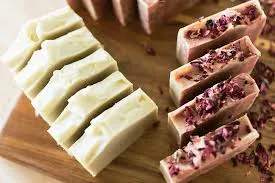Advanced crafters often seek out new ways to improve and innovate their soap creations. Cold process is one of the most traditional and artisan-friendly methods of creating soap from scratch. It allows you to create different designs with a variety of scents with only a few soap making supplies. Here are a few ways you can use popular techniques, materials, and sustainable practices in your craft:
Understanding the Cold Process
Cold process soap making starts by combining oils or butter with sodium hydroxide and water, also known as lye solution. Mixing these soap making supplies starts a chemical reaction known as saponification. The reaction naturally generates heat, without the need for an external heat source, and turns the mixture into soap.
Using Cold Process Techniques
Since the cold process is a versatile method of soap making, artisans are able to mix and match oils in varying proportions for different results. You can create soaps with different hardness, lather, and moisture. It’s easy to customize your creations by adding distinct horizontal or angled layers with different colors and textures, or creating delicate swirls. Cold process crafted soaps need more time to fully saponify. The curation process usually takes several weeks, which gives you more time to customize it. Since this technique doesn’t involve external heat, scents and colors tend to be better preserved.
Finding Soap Making Supplies
You’ll need a few tools, including safety gear and a precision scale, to use the cold process method effectively. If you want to craft unique soaps, there are also some key ingredients like oils and fragrances that will help you achieve that. Apart from the lye solutions, here are some of soap making supplies you may need:
- Natural Oils and Butters: These ingredients allow you to customize the texture and qualities of your creation. Coconut oil makes soaps with a bubbly, cleansing lather, while shea butter gives them a creamy texture.
- Colorants: Natural clays, powders, and mineral-based micas are used to give soap various colors. Since clays may add a mild exfoliating or oil-absorbing property, they can also change the soap’s texture.
- Fragrances: Essential oils can be used to provide natural aromatherapy, while fragrance oils allow you to create more complex scents. Cold process techniques don’t significantly affect the soap’s smell, and it helps them retain their additional properties.
- Precision Scale: Different ingredient measurements can change your soap’s smell, appearance, and properties. Using a precision scale helps you get more consistent and safer results.
- Molds: Molds come in a variety of materials, such as plastic, silicone, and metal. You can use these to easily create fun designs that match your soap’s color and scent.
- Safety Gear: Since cold process involves a chemical reaction, proper safety gear should always be used. You can get gloves, goggles, and a protective apron to complete your soap making setup.
Employing Soap Crafting Techniques
Advanced techniques allow you to create an artistic statement soap. Swirling techniques create intricate, fluid patterns that are unique to every batch. You can do this by mixing multiple colors in the soap itself before pouring it into the mold. The colors will blend and swirl together in a way that creates a marbled or tie-dye effect.
Layering can be used for more than creating colorful designs; it can also create different textures. Using additives like exfoliating grains gives the soap a more sophisticated look. Some artisans add dried flowers or herbs to give their soaps a more unique and organic aesthetic.
Using water-soluble embed paper lets you add your logo or intricate printed designs to your soap. This advanced method requires an inkjet printer with water-soluble ink. You’ll have to pour the first layer of soap, let it cool a bit until it forms a skin layer, and place the printed design, smoothing it out. Pour another thin layer of soap base and let it cure.
Embrace Sustainability in Your Soap Making Craft
Beyond crafting soaps that are both aesthetically pleasing and functional, some artisans embrace sustainable practices. A way for you to do this is by replacing plastic wraps with biodegradable options made of paper or reusable tins. Some ingredients, such as essential oils, also offer high-quality organic-certified options. If you’re selling your products, incorporating these sustainable practices could make your soaps appear more luxurious and high-quality to potential buyers. Discover new techniques and get good quality soap making supplies today.
Related Post:
- Jacksonville Computer Network Issue – Residents and Businesses!
- Kennedy Funding Ripoff Report – Uncovering the Facts and Complaints!
- Brent Evenstad – Visionary Entrepreneur and Philanthropist!
- Ancient Artz – Timeless Reflection of Human Creativity!
- Harmonicode – Unlocking the Future of Digital Harmony!


